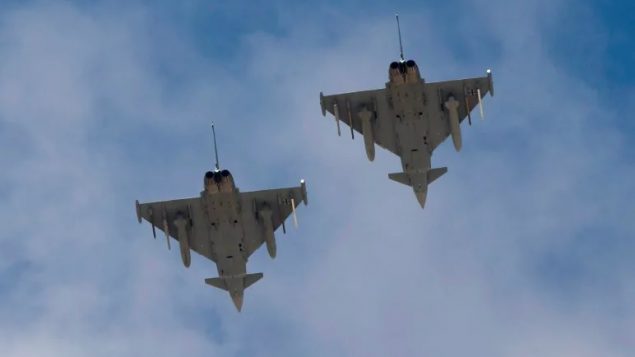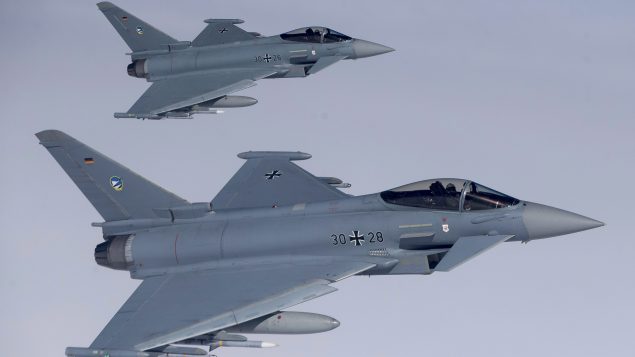And then there were three.
The United Kingdom’s Ministry of Defence and Airbus Defence and Space are withdrawing from the competition to replace Canada’s aging fleet of CF-18 jet fighters, Airbus officials announced Friday.
A statement by the company said the plane maker has informed the Liberal government that Airbus is withdrawing its Eurofighter Typhoon jet from Canada’s Future Fighter Capability Project (FFCP).
That leaves only three companies in the competition: Lockheed Martin Canada with its F-35; Boeing with the Super Hornet; and Sweden’s Saab, which is offering an updated version of its Gripen fighter.
The decision is the result of a detailed review of the Request for Proposal (RFP), following its release on July 23, 2019, Airbus said in a press release.
“Airbus Defence and Space is proud of our longstanding partnership with the Government of Canada, and of serving our fifth home country’s aerospace priorities for over three decades,” Simon Jacques, president of Airbus Defence and Space Canada, said in a statement.
“Together we continue in our focus of supporting the men and women of the Canadian Armed Forces, growing skilled aerospace jobs across the country and spurring innovation in the Canadian aerospace sector.”

Two German Eurofighter Typhoon fighter jets fly over Ovda airbase near Eilat, southern Israel during the 2017 Blue Flag exercise. (Ariel Schalit/The Associated Press)
Airbus officials said they “appreciate” Canada’s “commitment to transparency throughout the last two years as well as the thoroughly professional nature of the competition.”
- Fighter jet procurement: U.S. says Canada unfair, may pull F-35 out, but still wants Canada to buy U.S. jets
- Norway’s experience with F-35 fighter jets offers lesson for Canada
Two factors have led Airbus to withdraw from the project, the company said.
First, it looked at the NORAD security requirements and the cost it imposes on companies outside of North America.
Second, Airbus said it concluded that “the significant recent revision of industrial technological benefits (ITB) obligations does not sufficiently value the binding commitments the Typhoon Canada package was willing to make, and which were one of its major points of focus.”
Not a surprise, says expert
David Perry, vice president of the Canadian Global Affairs Institute who specializes in defence procurement issues, said the decision by Airbus did not come as a surprise, especially given the company’s concerns over the recent changes by the Liberal government to the industrial benefits portion of the tender to make it more fair to Lockheed Martin.
“If somebody had asked me which of the four companies were most likely to drop out, I would have guessed Airbus,” Perry told Radio Canada International.
“Their sense was they had really spent a lot of time emphasizing the ITB (Industrial and Technological Benefits) offering that they had and so when the government made the change, which I think it made for the right reasons, to allow Lockheed or anybody else to bid under an adapted economic offset package model, they had certainly expressed that they thought that would really change the rules of the game.”
Reaching full interoperability difficult for European aircraft
Another concern the company had mentioned in its press release was the difficulty and the cost of establishing the 2-EYES interoperability with U.S. systems that Canada is looking for, Perry said.
To reach the level of interoperability that Canada requires to be able to fulfil its NORAD obligations, it needs to have aircraft that can work seamlessly with American aircraft, which means being integrated into the U.S. intelligence sharing systems, Perry said.
These systems allow the aircraft not only to communicate with each other and the ground controls but also access highly sensitive intelligence data that the U.S. jealously guards.
“What it means is that you have to have a connection between your intelligence feed and the equipment on the aircraft,” Perry said. “Our intelligence is largely American-driven and having that match with American equipment is very easy because it’s U.S. national systems and the American equipment comes to Canada previously connected, because the American government connects it.”
This creates a big hurdle for European plane makers, he said.
“Their equipment isn’t always automatically connected to American systems,” Perry said.
Some analysts have argued that this question of interoperability essentially gives Lockheed Martin and Boeing an edge over their European competitors.
“Ultimately for us to buy a fighter aircraft and make it effective, it has to work seamlessly with the U.S. government, not just the U.S. Air Force but the rest of the U.S. government,” Perry said.
“And I think the general sense is that the United States has said that it will work with whatever aircraft Canada buys, but ultimately we need to make those aircraft work with very sensitive American intelligence systems.”
With files from Murray Brewster of CBC News







For reasons beyond our control, and for an undetermined period of time, our comment section is now closed. However, our social networks remain open to your contributions.